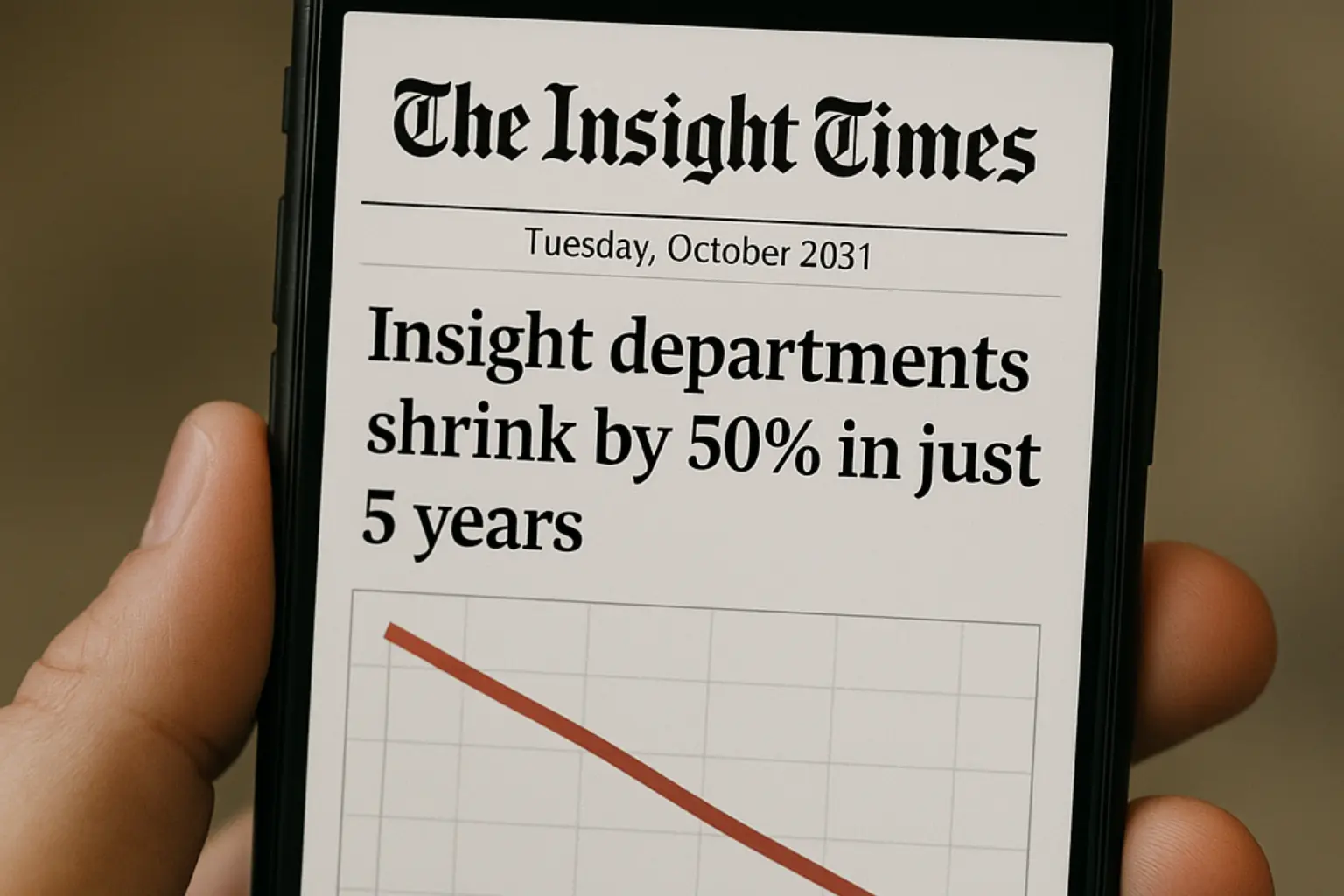I’ve been working in insights for over 30 years now (gulp!). And in that time there has been one challenge that has remained top of the industry’s wish list, while never being solved. The ‘seat at the top table’ challenge…
“How can the Insights function have a seat at the top table… and take its place as a strategic partner and growth driver, not just a data provider and cost line?”
The view that the top table issue isn’t solved appears to be backed up by hard data as well as anecdotal evidence we see all around us. A client quoted me a recent study that claims that only 25% of client side insight professionals feel their function is treated like a strategic partner. The other 75% felt like a process function - data providers. And of course the question remains, of those 25% who feel like strategic partners how many genuinely have a seat at the top table?
If the impact of AI is predominantly around speed, cost and other efficiencies in data collection and analysis we risk driving reductions in budgets and headcounts and diminishing the Insights function, not increasing its impact.
If automation and machine thinking replaces insights expertise, judgement and human empathy then we also diminish the very skills that has the potential to help shape strategic decision making and earn the right to sit at that table.
AI will be transformative, we should embrace it. But how we embrace it has the potential to shape whether the insights function thrives or dies. A strategic, energetic and transformational force with human empathy at its heart – or a provider of more efficient information to decision makers.
Much is written AI amplifying human ingenuity, but the question is whose ingenuity will it be amplifying? Will it be the senior insights leaders and their agency partners, or will it be senior marketers and other business decision makers, empowered by AI driven insight?
The benefits of AI and AI automation I think are well documented, so in this article we will focus on the risk factors and dig deeper into what they are, what we can do about them...
---
We’ve seen so much change over the years... The insights revolution, ethnography, semiotics, online research, consumer panels & communities, video research, knowledge management systems & dashboards, social media monitoring, co-creation, design thinking, storytelling, multimedia deliverables and the explosion in data sources and accompanying advanced analytics.
Whilst these have been enthusiastically embraced and have transformed the nature of the insights industry, the information we access and how our work is done, none appear to have had a significant impact on the top table challenge. They have changed how insight work is done, but not how the function is seen within the organisation.
AI is potentially the biggest transformational force of them all and will continue to have a radical impact on the insights function. But what impact will these changes have on the perennial top table challenge?
That’s a hard question to answer of course. Certainly, AI can make research and insights faster, more cost effective and it can also lead to better outcomes. But like the transformations of the past, is AI destined to fail when it comes to the top table challenge? Faster, cheaper results (and even better outcomes) are great but none guarantee greater commercial impact.
And there are signs that AI could actually make the situation worse rather than better. Here are some thoughts on how…
Too much content
AI makes it far easier to create more content… data, analysis, reports, presentations, ideas, concepts… people can easily create more ‘stuff’ than ever. However, volume of data and content has never been the problem… in fact it’s the opposite, the challenge is more about narrowing down to the essentials that drive commercial impact. With AI the Insights function is in danger of swamping businesses with more data, information and content, rather than focusing on sharper, consumer centric, decision making.
More complexity
The insight methodologies we have all known and trusted for decades are being reinvented. Revolutionising them with AI has the potential to make each step on the journey from question to decision more complex and hard for stakeholders to navigate and understand. The insights world can already feel like something of a dark art to decision makers, AI risks making this worse.
Increasing uncertainty
As methodologies and approaches are reinvented with AI there is a danger they become too opaque, too black box, for people to engage with and trust. The link between inputs and outcome is no longer easy to understand. Traditional consumer research isn’t perfect, it’s not an objective truth. But it’s familiar, tried and tested, its process and logic understandable, its limitations largely known and accepted. It’s a shared language. As this familiarity erodes will trust and confidence disappear with it?
Shrinking insights function
There has been a race to faster and cheaper data and insights for a while, AI is potentially accelerating this. Which in theory isn’t a problem. It can free up time and budgets to do more insight work across more projects, to have a greater impact. But cutting budgets could become addictive, the end goal in itself. If the insights function is already seen as a cost centre rather than a revenue driver then the temptation to continue to squeeze and squeeze could become too much for the business to resist.
Lost skills
The potential for over reliance on LLMs to diminish cognitive ability and skills is well documented recently. It’s not just a question of the next generation of talent not learning the required skills, it’s also the regressive impact on everyone who outsources thinking to machines. This is particularly important in insights. Human understanding and human empathy is what drives the value beyond the data and information that the insights function can provide. The ability to connect the dots, read between the lines, apply commercial context and influence people and organisations is vital. If this human value becomes eroded by over reliance on machine thinking, the insights function will be even less well placed to drive commercial impact.
Less collaboration
Building on the shoulders of giants is a well used phrase for a reason. Great advances typically appear through collaboration, diverse minds attacking a challenge from different angles, building on each other’s ideas. AI systems allow individuals to achieve more on their own, which can be great. But that also makes it easier for collaborative experiences to disappear. With so much remote working and with teams spread across multiple countries it’s hard to justify the budgets to bring people together. The incentive to save time and money is powerfully strong. The loss of the collaborative edge though, is hard to measure but might well make a profound difference when it comes to turning insight into impact
A shift to decision makers
But perhaps the biggest risk is that AI will cause the very need for an insights function to diminish. Insight work that once required internal teams and agencies with specialised skills, expertise and process management could become fully automated. Decision makers might only need to brief an AI system to get what they need to make decisions, not an insights team. The less human value the insights function is seen to deliver right now, the more likely it is that it will be sidelined in the future.
All of this probably sounds rather depressing, and perhaps a surprisingly negative view of AI coming from someone who runs an AI first agency. But for me these aren’t reasons to reject AI. They are reasons to be mindful about how we embrace it.
We need to show the insights function can embrace AI in a way that…
- Sharpens thinking, not drowns in content
- Creates simple but effective tools and processes that give people clarity
- Brings decision makers with us on the journey, so there is trust and confidence in new ways of working
- Champions better outcomes and drive commercial impact, not just saves time and cost
- Nurtures talent and skills around human understanding, empathy and commercial impact
- Enables collaboration in new and innovative ways
- Proves that human insight in the loop creates commercial value that full automation would destroy.
A seat at the top table will be earned through the intelligent use of what AI enables to help shape strategic decisions and have measurable commercial impact.
We need to make sure the insights industry is there and at its strongest to provide this expertise and to champion the human dimension at the heart of brands.
That time and resources freed up from process can be focussed on creating an insights function with the experience, skills and expertise to represent the voice of the consumer at the top table in a way that shapes measurable commercial impact.
Maybe if we do it right AI will help us solve this ‘seat at the top table’ issue once and for all!
Image - Chat GPT
.png)




